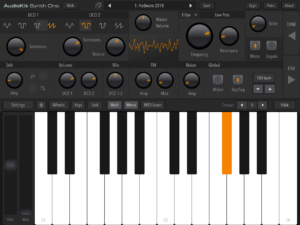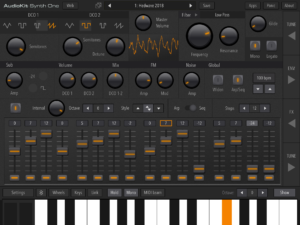The open source movement revolutionized the technology world by changing how software gets written. A stunning amount of today’s tech products boast at least a partial open source background. Its community-driven focus attracts talented developers wanting to learn, contribute, and be a part of something bigger than simply schlepping code for some faceless corporation.
AudioKit is an open source audio framework for the iOS platform. The team behind AudioKit recently introduced Synth One, an open source synthesizer making waves throughout the iOS musician community. Let us dive into the details to see how this free synth just might be one of the best music apps available for Apple’s mobile platform.
AudioKit Synth One Features
- Virtual Analog/FM Polysynth
- Five Oscillators (DCOx2, FM, Sub, Noise)
- Two LFOs with a Ton of Routing Options
- 16-Step Sequencer and Arpeggiator
- ADSR Envelopes for Amp and Filter
- 4-Pole Lowpass Filter
- Highpass and Bandpass Filters
- Reverb, Delay, and More
- Over 300 Presets from Top Sound Designers
- Bluetooth MIDI and MIDI Learn
- Audiobus, IAA Support
- AUv3 and MPE Support Soon!
- Available for Free at the iTunes App Store
Simply put, Synth One belongs in the library of any iOS musician. The same rule applies even if the app cost $10-20! It truly is one of the best synth apps on the iPad or iPhone. Find out why.
An Intuitive Interface makes Synth Programming Easy!
Synth One sports a clean and intuitive interface. A small row at the top handles patch management as well as some “housekeeping” functionality. The meat of the interface lies within two larger windows with a pair of buttons at the right used to navigate between different pages. A resizable keyboard lies at the bottom of the screen.
One cool perk of the two-window interface lets you keep the main screen in the top window, while navigating the rest of the pages in the bottom window. This concept also works with other pages, and is especially useful when using the Kaoss-inspired X-Y Pad screen. It’s the kind of UI flexibility one expects from an engaged developer community.
Other pages handle the envelopes, effects, master tuning (with over 100 alternate tunings), and the 16-step sequencer. Don’t worry; those prog-friendly odd time signatures are supported! The interface buttons and switches are large; providing a smooth and easy operating experience.
Great Sonics highlight this Free iOS Synth App
Simply put, Synth One offers stunning sound quality for the iOS platform. The synth app easily produces everything from spacey pads to searing analog leads to freaky FM bells with hardly a sweat. The embedded Costello reverb and multi-tap delay definitely help in this regard.
The synth architecture follows a standard subtractive model. The two DCOs let you gradually vary between the different waveforms, like the Moog Sub 37 and other hardware synths. It beats simply switching between waves like most synths. An FM oscillator, suboscillator, and a noise circuit round out the five oscillator setup.
You use the knobs for controlling the ADSR settings on both envelopes. Even cooler is simply drawing the envelopes with the touchscreen. The two LFOs offer four different waveforms as well as a host of routing options. A phaser combines with the previously mentioned reverb and delay in the effects section. Use the bitcrusher to mangle the sound even more; making it an LFO destination gives your patch some motion.
The intuitive 16-step old school sequencer works perfectly. Two X-Y pads mentioned earlier also add to the fun. The tuning and pitch screen lets you switch between the over 100 alternate tunings. A colored pitch indicator provides some visual candy, especially when performing a sequence.
An Open Source Revolution for iOS Music Apps
Obviously as the product of a robust open source community, Synth One enjoys regular updates. The team is currently working on AUv3 support. Any delay in its release is related to programming things the right way so other interested iOS music app developers are able to use the same source code for their own apps.
That last point perfectly speaks to the positive impact made by open source software throughout the tech world. It appears iOS musicians – and developers – are now able to reap these same benefits. A thousand thanks to the team at AudioKit! Join up if so inclined!
If you haven’t yet downloaded AudioKit Synth One – get to it! It will likely become an indispensable part of your mobile music production workflow. By the way, AudioKit’s FM Player synth is also worth a free download.


